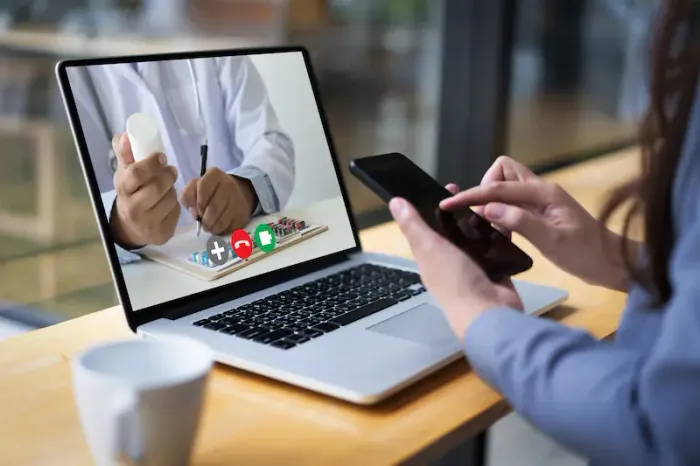Online Doctor Consultation Get 247 Expert Medical Advice
Get 24/7 medical advice from licensed clinicians via telemedicine. Learn when an online doctor visit works, what to expect, costs, privacy, and safety.

Written by Dr. Mohammed Kamran
Reviewed by Dr. Shaik Abdul Kalam MD (Physician)
Last updated on 17th Nov, 2025

Introduction
Health questions don’t always wait for office hours. With telemedicine, an online doctor can answer questions, assess symptoms, and guide your next steps anytime, from home. Whether you’re managing a chronic condition, facing a new health concern, or need quick guidance for your child’s symptoms, virtual care can be a safe, convenient way to connect with a clinician when you need it most.
What Is Telemedicine and How Does It Work?
Telemedicine uses secure technology—like video calls, phone calls, chat, and patient portals—to deliver health care remotely. You can receive advice, treatment, follow-up care, prescriptions when appropriate, and referrals without travelling to a clinic.
Here’s what typically happens:
• You book a virtual visit using a website or app.
• You share your symptoms, medical history, medications, and allergies.
• You meet your clinician through a secure video or phone connection.
• The clinician evaluates your concerns, may visually examine certain issues (like rashes), and discusses a plan.
• You receive instructions, a care summary, any recommended prescriptions (subject to local regulations), and follow-up steps or referrals.
Why It Matters
• Convenience: Attend visits from home, work, or while travelling.
• Speed: Same-day or on-demand appointments are common.
• Access: Helpful for people in rural areas or with mobility challenges.
• Continuity: Useful for follow-ups, medication checks, and ongoing care plans.
When Is an Online Doctor Visit Right for You?
Virtual visits work best for non-emergency needs and many routine concerns. Consider using one for:
• New, mild symptoms where you need quick guidance
• Chronic condition check-ins (e.g., blood pressure or diabetes follow-ups)
• Medication reviews, renewals when appropriate, and side-effect checks
• Skin issues that can be seen on camera (rashes, acne, insect bites)
• Minor infections or symptoms (sore throat, cough, sinus congestion, uncomplicated urinary symptoms)
• Allergies, mild asthma follow-ups, and seasonal issues
• Digestive complaints (mild nausea, heartburn, constipation)
• Mental health support (therapy or medication follow-ups, depending on local services)
• Sleep concerns, headache reviews, and migraine management plans
• Basic wellness care and preventive counselling
What Problems Are a Good Fit for Virtual Care?
Examples include:
• Cold and flu-like symptoms without severe distress
• Pink eye and minor eye irritation
• Simple musculoskeletal issues (mild back pain, sprains)
• Mild skin infections or eczema flares
• Travel health advice and certain prophylactic prescriptions (per local rules)
• Lab review and test result discussions
• Nutrition, weight management, and lifestyle counselling
What Should Not Be Handled Virtually?
Seek in-person or emergency care for:
• Chest pain, trouble breathing, signs of stroke (sudden weakness, facial droop, confusion, speech trouble), severe allergic reactions, or heavy bleeding
• Severe abdominal pain, high fever with stiff neck, or confusion
• Serious injuries, suspected fractures requiring imaging, or deep wounds
• Pregnancy emergencies or concerning pregnancy symptoms
• Any situation where your condition is rapidly worsening or you’re unsure and feel unsafe waiting.
If you think you might be having a medical emergency, call your local emergency number immediately.
How a Virtual Visit Works, Step by Step?
Here’s a step-by-step guide on how a virtual visit works:
Before Your Appointment
• Choose a quiet, well-lit space with a stable internet connection.
• Have your ID, insurance card (if using insurance), medication list, and recent vitals (blood pressure, blood sugar, temperature) if available.
• Write down your main concerns, when they started, what makes them better or worse, and any home treatments you’ve tried.
• Prepare clear photos of rashes or skin concerns in good lighting if requested.
• Test your camera, microphone, and app login ahead of time to avoid delays.
During the Visit
• Describe your symptoms in your own words. Be honest and specific.
• Share your medical history, allergies, and all medications (including supplements).
• Ask questions about diagnosis possibilities, the care plan, and warning signs that should prompt an in-person visit.
• Clarify follow-up steps: When should you check back? Will you receive a summary? How can you message the clinic if questions come up?
After the Visit
• Review your visit summary and instructions.
• Pick up any prescribed medications and follow dosage directions.
• Schedule follow-up care as advised (virtual or in-person).
• Monitor your symptoms and watch for any red flags outlined by your clinician.
Safety, Quality, and Privacy You Can Trust
Your health information should be handled with the same care online as in a clinic. Look for:
• Secure platforms: End-to-end encryption and clear privacy policies
• Licensed clinicians: Credentials listed and verifiable
• Informed consent: Clear explanation of how the visit works, what it can and cannot do, and how your data is used
• Local compliance: Platforms should follow healthcare privacy laws where you live (for example, HIPAA in the United States)
Reputable health systems and clinics use secure tools and established clinical guidelines to ensure safe, evidence-based care. For some conditions and follow-ups, virtual visits can be comparable to in-person care; for others, an in-person exam, labs, or imaging may be required. If your clinician recommends an in-person evaluation, it’s to protect your health and ensure you get the right tests and treatment.Consult Top Specialists
Prescriptions and Lab Work: What to Expect
• Prescriptions: Many common medications can be prescribed after a virtual evaluation when appropriate. Rules for prescribing, especially for controlled substances, vary by location. Your clinician will follow local laws and safety standards.
• Labs and imaging: If you need tests, your clinician can order them at a nearby facility. Results can often be reviewed in a follow-up virtual visit.
• Referrals: You may be referred to an in-person specialist, urgent care, or emergency services if needed.
Costs, Insurance, and Saving Money
• Insurance coverage: Many insurers and health systems cover virtual visits, but benefits vary by plan and region. Check your plan details or ask the clinic’s billing team before your appointment.
• Out-of-pocket prices: Some services publish flat fees for virtual visits, which can be lower than urgent care or emergency department costs for non-emergencies.
• Tips to reduce costs: Use in-network providers, ask for generic medications when appropriate, and request a detailed visit summary for flexible spending account reimbursement if applicable.
How to Choose a Trusted Virtual Care Service?
Here’s how to choose a trusted virtual care provider:
• Verify licensing and credentials. Make sure clinicians are licensed to practice where you are located (requirements vary by region).
• Check the platform’s security. Look for encryption, secure logins, and a clear privacy policy.
• Read reviews and patient feedback. Look for consistent comments about quality, communication, and wait times.
• Confirm availability. Many services offer 24/7 support for non-emergency concerns.
• Ask about follow-ups. Reliable services provide visit summaries, messaging, or easy scheduling for rechecks.
• Consider language and accessibility needs. Look for interpreters, captioning, or adaptive features if needed.
Tips to Get the Most From Your Virtual Visit
Here’s how to be ready before your virtual visit:
• Be ready with your main question: “What is the most likely cause of my symptoms, and what should I do next?”
• Share a focused timeline: When symptoms started, how they progressed, and any home measurements (temperature, oxygen saturation if available).
• Use photos or good lighting to show visible issues (skin, eyes, wounds).
• Take notes. Write down medication instructions, warning signs, and follow-up plans.
• Ask about self-care steps to support recovery (hydration, rest, over-the-counter options if safe for you).
• Confirm how to reach the clinic if your symptoms change.
Special Considerations for Children, Older Adults, and Caregivers
• Children: Virtual visits can be helpful for rashes, mild respiratory symptoms, pink eye, and behavioural or sleep questions. For infants or if a child appears very ill, in-person evaluation may be safer.
• Older adults: Virtual care can reduce travel burdens. If technology is a barrier, a caregiver can help set up the visit. Share full medication lists and any recent falls, confusion, or new weakness.
• Caregivers: Keep a health diary, medication list, and recent vitals for the person you support. Ask for written care plans and clear thresholds for when to escalate care.
Virtual Care and Chronic Conditions
For many ongoing conditions, virtual check-ins support steady progress:
• Hypertension: Share home blood pressure readings and discuss medication adjustments if advised.
• Diabetes: Review glucose logs, nutrition, and medication timing.
• Asthma/COPD: Discuss inhaler technique, triggers, and action plans.
• Mental health: Therapy, medication follow-ups, and coping strategies can often be managed remotely.
• Heart disease: Review symptoms, medications, and lifestyle changes; urgent symptoms still require in-person care.
Red Flags: When to Switch to In-Person or Emergency Care
Go to urgent care or the emergency department if you have:
• Severe chest pain, shortness of breath, fainting, or signs of stroke
• High fever with severe headache or neck stiffness
• Severe abdominal pain, persistent vomiting, or blood in stool or vomit
• A serious injury, uncontrolled bleeding, or a deep wound
• New confusion, severe dehydration, or rapidly worsening symptoms
If in doubt, ask your clinician during the virtual visit—safety comes first.
Bottom Line
Virtual care offers quick, convenient access to licensed clinicians, especially for common illnesses, minor injuries, mental health support, and routine follow-ups. It doesn’t replace emergency care or situations that require a physical exam or testing, but it can save you time, reduce travel, and help you make confident decisions about next steps. With a secure platform, a clear care plan, and attention to red flags, you can use virtual visits as a safe, effective part of your health routine.Consult Top Specialists
Consult Top Specialists

Dr. Anand Ravi
General Physician
2 Years • MBBS
Bengaluru
PRESTIGE SHANTHINIKETAN - SOCIETY CLINIC, Bengaluru

Dr Syed Mateen Pasha
General Physician
2 Years • MBBS
Bengaluru
PRESTIGE SHANTHINIKETAN - SOCIETY CLINIC, Bengaluru

Dr. Harshendra Jaiswal
General Physician/ Internal Medicine Specialist
12 Years • MBBS , MD (General medicine)
Kolkata
108 DHANA DHANVANTARI Clinic, Kolkata
(25+ Patients)

Dr. Syed Ismail Ali
General Practitioner
7 Years • MBBS
Hyderabad
Apollo 24|7 Clinic, Hyderabad
Dr. Thandra Ramoji Babu
General Physician/ Internal Medicine Specialist
5 Years • MBBS, DNB(General Medicine)
Warangal
Sai Ram multi-specialty hospital, Warangal
Consult Top Specialists

Dr. Anand Ravi
General Physician
2 Years • MBBS
Bengaluru
PRESTIGE SHANTHINIKETAN - SOCIETY CLINIC, Bengaluru

Dr Syed Mateen Pasha
General Physician
2 Years • MBBS
Bengaluru
PRESTIGE SHANTHINIKETAN - SOCIETY CLINIC, Bengaluru

Dr. Harshendra Jaiswal
General Physician/ Internal Medicine Specialist
12 Years • MBBS , MD (General medicine)
Kolkata
108 DHANA DHANVANTARI Clinic, Kolkata
(25+ Patients)

Dr. Syed Ismail Ali
General Practitioner
7 Years • MBBS
Hyderabad
Apollo 24|7 Clinic, Hyderabad
Dr. Thandra Ramoji Babu
General Physician/ Internal Medicine Specialist
5 Years • MBBS, DNB(General Medicine)
Warangal
Sai Ram multi-specialty hospital, Warangal
More articles from General Medical Consultation
Frequently Asked Questions
Q1: Is a virtual visit as good as an in-person visit?
It depends on the issue. Many common concerns, follow-ups, and medication checks can be safely managed virtually. If a physical exam, labs, or imaging are necessary, your clinician will recommend in-person care.
Q2: Can a clinician prescribe medication after a virtual visit?
Often, yes—when it’s safe and appropriate. Rules for certain medicines, especially controlled substances, vary by location. Your clinician will follow local laws and clinical guidelines.
Q3: What equipment do I need?
A smartphone, tablet, or computer with a camera and microphone; a stable internet connection; and a private, well-lit space. If you have home devices (thermometer, blood pressure cuff, glucometer), have them handy.
Q4: Will my information be secure?
Reputable platforms use secure connections and follow privacy laws in your region (for example, HIPAA in the U.S.). Check the platform’s privacy policy and ensure you’re on a secure network.
Q5: How do I know if a virtual visit is right for my symptoms?
If your symptoms are mild to moderate and not urgent, a virtual visit is often a good first step. For severe, rapidly worsening, or emergency symptoms, seek in-person or emergency care right away.




